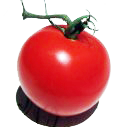Canning 101: Strawberry Jam
Ever cook something out of your comfort zone, then find out it wasn’t too tricky after all? I feel this way about canning now, after just one class where I was reassuringly taught that canning-for-beginners is simply a matter of knowing the basics & following the recipe. Not that following recipes is my strong suit…
Anyway, I recently signed up to take a “Canning 101” class at a restaurant called The Goodland Kitchen in Goleta, CA. I had never canned anything before, and had never made any kind of jam either (other than the stuff you swirl into the batter when you’re using America’s Test Kitchen’s recipe for blueberry muffins). The class also covered pickling! This, I admit, was its main appeal for me. But more on that in another post… back to the jamming.*
As tempted as I am to just make a bulleted list of the Things I Learned About Canning that I didn’t know before, that would cover pretty much everything, so instead I will summarize what seemed to be the most important points.
First, there are two main types of canning: pressure canning (using a pressure cooker), or canning in a boiling water bath. The acidity in your jars will determine which kind of canning you can use: low acid foods require a pressure cooker, whereas high acid foods can be canned in boiling water. You might think that strawberries would be acidic enough on their own for the water bath canning, but actually most strawberry jam recipes call for a little bit of lemon juice to bring the acidity up. (Plus, the flavor of lemon goes nicely with strawberry.)
Second, although you can re-use your canning jars and screw rings that fit around the tops, you need to use NEW lids each time you can. And before you lower your jars into the boiling water bath, you want both the jars and lids to be nice and hot, so the glass won’t crack (no need to heat the rings). This is a simple matter of: 1) boiling the lids in water until just before you’re ready for them, then removing them with a slotted spoon (or a magnetic canning “wand”); 2) filling the jars while the contents are still hot from cooking; and 3) being very speedy about it so everything stays hot.**
Third, when you’re making jam, you can mash the fruit as much or as little as you want, and “set” the jam at any point depending on when you add the pectin! (In other words, you can choose to end up with whole fruit in syrup, roughly-mashed jam with plenty of whole berries left in it, or completely smooth preserves, just by adding the pectin at different points in the cooking/mashing process.)
This recipe for Strawberry Jam*** is the one we made in the class (although in class we quadrupled it), but apparently almost any box of pectin you buy will come with its own jam recipes. And the Pomona’s Pectin that we used even has a “Jam Hotline” if you’re canning and you get into… I’m not even going to say it.
* Apparently canners refer to making and canning jam as “jamming,” which I’m sure many a musician would find amusing.
** Once you place the heated lids onto the jars, you need to be careful not to screw the rings on too tightly, or else air bubbles won’t be able to escape while the jars are under water: a good trick is to set the jar down, and use only one hand to spin the screw ring around and around until the moment the ring starts to turn the jar below with it. That’s when you know it’s tight enough, and you can immediately transfer the jar into the boiling water bath– using either jar-lifting tongs or hot water gloves— while the jar is still hot.
*** A note on the sugar content: it turns out that this is actually a pretty “low-sugar” recipe. (And one of the advantages of using Pomona’s Pectin is that it causes the jam to gel with a lot less sugar than some other pectins do.) You may think that 1 cup sugar: 4 cups strawberries sounds like a lot, but there’s a blackberry jam recipe out there that calls for 10 cups of blackberries and 14 (!) cups of sugar.
Print this recipe. (PDF)
RECIPE:
Strawberry Jam
(from the Canning 101 class at The Goodland Kitchen, Goleta, CA)
(makes enough to fill about 4 half-pint jars)
Ingredients:
~ 4 cups strawberries, halved or quartered
~ 1 cup sugar
~ 1/4 cup lemon juice
~ 2 tsp. pectin powder
~ 2 tsp. calcium water (NOT 2 tsp. of the powder for making calcium water that comes in the pectin box; instead use 2 tsp. of the water itself: follow package instructions to prepare it.)
How to make it:
1. Wash jars in hot, soapy water, and rinse well. Put metal jar lids into a pan of water and bring to a boil, then turn off the burner and let the lids stand in the hot water.
2. Bring a separate large, very deep pot of water to a boil. This will be your boiling water bath to seal the jars. The pot should be deep enough that the jars can be fully submerged in the water without the water boiling up and over the sides. Also take a moment to mix up some calcium water in a small dish or glass, according to the directions in the pectin box (it will tell you the calcium-powder-to-water ratio).
3. Then prepare the fruit: wash strawberries, cut off stems, and halve or quarter the berries. Then transfer to a pot, mash the strawberries a bit (a potato masher works well), and add lemon juice and half of the sugar.
4. Bring the mashed strawberries to a boil, stirring frequently, and boil for 10-15 minutes, continuing to stir (especially once it begins to thicken, so the berries won’t burn).
5. Meanwhile, mix the pectin into the other half of the sugar. Once the berries have been cooked down to the point where you want them to gel into jam, add 2 tsp. of the calcium water and add the pectin/sugar mixture. Then stir vigorously for 1-2 minutes to dissolve the pectin.
6. Fill the jars immediately while the jam is still hot. We used a small plastic pitcher to scoop up jam, and a canning funnel (not a necessity) to guide the jam into the jars without making too much of a mess. Leave 1/4 inch of “headspace,” or unfilled area at the top of the jar, right under the lid. Then carefully pick up the hot lids (using a slotted spoon or magnetic “wand”), place them on the jars, and screw on the rings over that, but not too tightly (see footnote ** above).
7. Immediately, while jars are still hot, transfer to boiling water bath (using canning tongs or hot water gloves; see footnote ** above). Make sure each jar is submerged in the hot water, and be careful to keep each jar upright, without tilting it too much. Keep in boiling water for 10 minutes, then remove– keeping jars upright– and let cool for 24 hours so the jam can fully set. (Best eaten within six months before the strawberries lose their color, but you can still eat it even then; Refrigerate after opening.)
A final tip: if you’re really using a lot of berries, you don’t have to cut & can on the same day; you can cut the berries, toss them in half of the sugar, and let them sit overnight, then mix the pectin into the other half of the sugar to add when you’re making jam the next day.
Print this recipe! (PDF)
Related recipe posts:
> Canning 101: Pickled Green Beans
> Canning 102: No-Pectin Fig Jam
> Homemade Chive Butter





























You know, being able to can food means you can send it from California *all the way* over to Wisconsin!!
Hm, I’ll take that into consideration. : ) You guys would need it more than I do, since your farmer’s market is probably ending about now, but the ones in California are all year long…
So glad you finally got to take the class! :)
Yes, thank you so much for telling me about TGK! And I’ve been meaning to tell you that the canning class teacher, Melissa, told me that she knew you from Fairview Farms and asked me if we knew each other through linguistics :)
I’ve been trying to use Pomona’s for two years now and just couldn’t get it to work properly. I tried your recipe and voila! I’m wondering if using ‘fresh from the farm’ berries makes a difference in liquid content and therefore boiling 10 – 15 minutes beforehand, as you suggest, makes all the difference. I can never phone the company as I’m always canning on the weekend between work days.
I’m so happy to hear that this method worked well for you! It’s really the recipe of the canning class I took; not my own, but I do think it’s a perfect one. And probably boiling the berries a bit in lemon juice and sugar not only reduces their liquid content but brings out a little more of the flavor as well.
Wow, what fantastic photos, explained to well. Thank you for posting and for stopping by my blog! That Kumquat Cardamom Marmalade looks amazing! on my list!
Thanks for stopping by my blog as well! Yes, we’ve really been enjoying the Kumquat Cardamom Marmalade… especially with Greek yogurt or on toast. :)
That sounds so good, I am so on that… I have to find Kumquats… would they be out now?
I’m not sure… they seemed to be going strong on my friend’s tree when I made the marmalade just over a month ago! (But then again it’s a citrus fruit so it’s technically a winter fruit.)
This looks great Alison. It’s been too long since I have eaten strawberry jam and your post has made me think of nothing else. My next day off out the kitchen I am making this, thanks for sharing. Also thanks for the follow – keep up the good work.
Awesome, thanks for stopping by and commenting! :) I’m glad I’ve inspired some jam-making for your next day off. It’s been too long since I’ve made strawberry jam as well (although I just took some rhubarb strawberry bars out of the oven in the middle of writing this comment!). Strawberry jam is such a basic, lovely recipe, so I know it’s one that I’ll keep going back to.